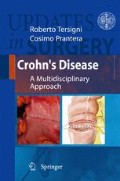Abstract
Gastrointestinal histopathology represents approximately half of the current work-flow in our laboratory, and six to ten of the reports signed out daily concern patients studied for Crohn’s disease (CD). This chapter summarizes the role of the pathologist in the management of patients with CD, starting from a glossary of the terms used in the information exchange between the pathologist radiologist gastroenterologist, and surgeon. This multidisciplinary team approach is crucial for the correct management of CD patients. The gastrointestinal tract has limited patterns of tissue response to triggers of inflammation and the diagnosis therefore relies upon the various combinations of these patterns with the clinical picture. The study of endoscopic specimens is based not only on a histopathological scheme but also on the presentation of the patient, which is of equal importance. Due to the limits in the information that can be extracted by studying the morphology of inflammation, molecular biology is expected to play an increasingly important role in providing the clinician with insight into the disease process in a single CD patient and thus in allowing the appropriate treatment strategy to be tailored accordingly.
Access this chapter
Tax calculation will be finalised at checkout
Purchases are for personal use only
Preview
Unable to display preview. Download preview PDF.
References
Levi GS, Harpaz N (2006) Intestinal low-grade tubuloglandular adenocarcinoma in inflammatory bowel disease. Am J Surg Pathol 30(8):1022–1029
Yantiss RK, Odze RD (2007) Pitfalls in the interpretation of non neoplastic mucosal biopsies in inflammatory bowel disease. Am J Gastroenterol 102:890–904
Garcia-Osogobio S, Takahashi T, Gamboa-Dominguez A et al. (2000) Toxic pseudomembranous colitis in a patient with ulcerative colitis. Inflamm Bowel Dis 6:188–190
Papadakis KA, Tung JK, Binder W (2001) Outcome of cytomegalovirus infections in patients with inflammatory bowel disease. Am J Gastroenterol 96:2137–2142
Lutgens MW, Vleggaar FP, Schipper ME et al. (2008) High frequency of early colorectal cancer in inflammatory bowel disease. Gut 57(9):1246–1251
Stange EF, Travis SP, Vermeire S et al (2006) European Crohn’s and Colitis Organisation. European evidence based consensus on the diagnosis and management of Crohn’s disease: definitions and diagnosis. Gut 55(Suppl) 1:i1–i15
Prantera C, Lochs H, Campieri M et al (2006) Antibiotic treatment of Crohn’s disease: results of a multicentre, double blind, randomized, placebo controlled trial with rifaximin. Aliment Pharmacol Ther 23:1117–1125
Touitou I, Notarnicola C, Grandemange S (2004) Identifying mutations in autoinflammatory diseases: towards novel genetic tests and therapies? Am J Pharmacogenomics 4(2):109–118
Ferrante M, de Hertogh G, Hlavaty T et al (2006) The value of myenteric plexitis to predict early postoperative Crohn’s disease recurrence. Gastroenterology 130(6):1595–1606
Ng SC, Lied GA, Kamm MA et al (2009) Predictive value and clinical significance of myenteric plexitis in Crohn’s disease. Inflamm Bowel Dis. Mar 31. (DOI) 10.1002/ibd.20932
Geboes K, Van Eyken P (2009) Inflammatory bowel disease unclassified and indeterminate colitis: the role of the pathologist. J Clin Pathol 62:201–205
Tsang P and Rotterdam H (1999) Biopsy diagnosis of colitis. Possibilities and pitfalls. Am J Surg Pathol 23:423–430
Geboes K (2001) Pathology of inflammatory bowel disease (IBD): variability with time and treatment. Colorectal Dis 3:2–12
Shepherd NA (2002) Granulomas in the diagnosis of intestinal Crohn’s disease: a myth exploded? Histopathology 41:166–168
Cuvelier C, Demetter P, Mielants H et al (2001) Interpretation of ileal biopsies: morphological features in normal and diseased mucosa. Histopathology 38:1–12
Odze R (2003) diagnostic problems and advances in inflammatory bowel disease. Mod Pathol 16:347–358
Peyrin-Biroulet L, Desreumaux P, Sandborn VJ et al (2008) Crohn’s disease: beyond antagonists of tumour necrosis factor. Lancet 372:67–81
Simms LA, Doecke JD, Walsh MD et al (2008) Reduced alpha-defensin expression is associated with inflammation and not NOD2 mutation status in ileal Crohn’s disease. Gut 57:903–910
Salim SY, Silva MA, Keita AV et al (2009) CD83+CCR7-dendritic cells accumulate in the subepithelial dome and internalize translocated Escherichia coli HB 101 in the Peyer’s patches of ileal Crohn’s disease. Am J Pathol 174:82–90
Laerum OD, Illemann N, Skarstein A et al (2008) Crohn’s disease but not chronic ulcerative colitis induces the expression of PAI-1 in enteric neurons. Am J Gastroenterol 103:2350–2358
Holta V, Klemetti P, Sipponen T et al (2008) IL23/IL 17 immunity as a hallmark of Crohn’s disease. Inflamm Bowel Dis 14:1175–1184
Danese S, Sans M, Scaldaferri F et al (2006) TNF-alpha blockade down-regulates the CD40/CD40L pathway in the mucosal microcirculation: a novel anti-inflammatory mechanism of infliximab in Crohn’s disease. J Immunol 176:2617–2624
Wu F, Zikusoka M, Trindade A et al (2008) MicroRNAs are differenttiallyexpressed in ulcerative colitis and alter expression of macrophage inflammatory peptide-2 alpha. Gastroenterology 135:1624–1635
Author information
Authors and Affiliations
Editor information
Editors and Affiliations
Rights and permissions
Copyright information
© 2010 Springer-Verlag Italia
About this chapter
Cite this chapter
Pisa, R., Macciomei, M.C., Leone, A. (2010). The Role of the Pathologist in the Management of Patients with Crohn’s Disease. In: Tersigni, R., Prantera, C. (eds) Crohn’s Disease. Updates in Surgery. Springer, Milano. https://doi.org/10.1007/978-88-470-1472-5_4
Download citation
DOI: https://doi.org/10.1007/978-88-470-1472-5_4
Publisher Name: Springer, Milano
Print ISBN: 978-88-470-1471-8
Online ISBN: 978-88-470-1472-5
eBook Packages: MedicineMedicine (R0)

